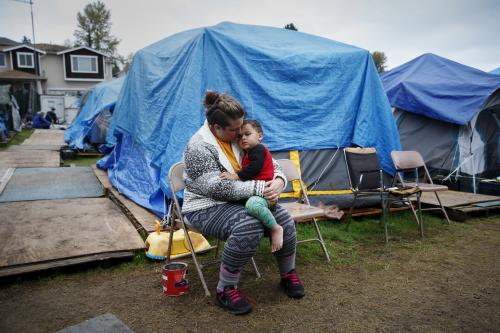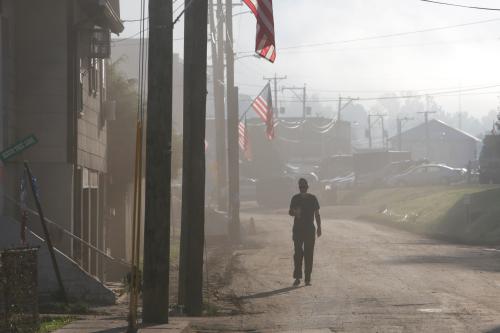Over the past several years, stark disparities in well-being have emerged among less educated segments of the U.S. population, revealing pockets of extreme desperation and despair. Most notably, minorities, who have traditionally faced discrimination, are much happier and less frustrated than are poor and uneducated whites who live primarily in suburban and rural areas in the heartland. Rising mortality among uneducated whites is the starkest marker of this desperation and is driven by preventable deaths such as suicides and opioid poisoning. No surprise, then, that the 2016 U.S. presidential election exposed deep societal divisions across America.
These trends reflect a social crisis with multiple and complex causes, not all of which we fully understand. An important first step is to document the extent of the crisis and to seek a deeper understanding of its causes. We hope that the results of our research, reported in this paper and based on metrics of well-being, such as life satisfaction and hope for the future on the one hand, and stress, worry, and pain on the other, can contribute to that effort.
Our metrics highlight the high costs of being poor in the land of the American Dream, where the focus is on opportunity and individual success, with little consensus around society’s collective responsibility to care for those who fall behind. Our metrics uncover costs that are less in the form of the material deprivation more typical of poverty in poor countries, and more in the form of stress, insecurity, poor health, and lack of hope.1 These costs manifest themselves differently across race and place, and show up among poor and uneducated whites in the form of deep desperation.
Their situation is characterized by lack of hope and aspirations for the future, high levels of unemployment, stark markers of poor health, such as diabetes, obesity, and drug and alcohol addiction, and rising mortality rates driven by preventable deaths from causes such as suicide and opioid poisoning—particularly (but not only) among the middle aged. These trends stand in sharp contrast to high levels of optimism and psychological resilience, gradually improving health indicators, and a closing of the gap in mortality rates among their poor black and Hispanic counterparts.
What explains these surprising trends, which are, at least among wealthy countries, unique to the U.S.? A number of studies have focused on differential trends in mobility (and especially fear of downward mobility, Cherlin 2016); differential health behaviors across place (Chetty et al., 2016); inequality of opportunity (Chetty et al 2014); and structural economic trends. The latter include the bottoming out of manufacturing in many regions and a related increase in dropouts from the labor market (Krueger, 2016), among other explanations.2
The unhappiness and lack of hope related to these trends, meanwhile, has potential linkages to longevity in general. Happier people tend to be healthier and more productive (Graham, 2008; Graham, Eggers, and Sukhtankar, 2004; deNeve et al. 2013).3 And individuals with a greater sense of purpose—described as eudemonic well-being by some economists and psychologists, and as “flourishing” by others—also tend to live longer (Steptoe, Deaton, and Stone, 2015; Keyes et al., 2012).4
Steptoe, Deaton, and Stone use the English Longitudinal Study of Aging (ELSA) and standard measures of eudemonia, such as autonomy, sense of control, and purpose in life and found that the mortality rate over eight years was 30 percent in the lowest quartile of well-being, but only 9 percent in the highest quartile. Keyes et al. use the U.S. Midlife Development in the U.S. (MIDUS) data from 1995 through 2010, and found that individuals with positive scores on 6 out of 11 (similar) eudemonic questions in that survey have lower adjusted risk of all-cause mortality. The same respondents were less likely to use tobacco and more likely to be physically active.
In November 2015, Anne Case and Angus Deaton published a path-breaking study showing a marked increase in the all-cause mortality of high school (and below) educated white middle-aged non-Hispanic men and women between 1999 and 2013.5 The change reversed decades of progress in mortality; it is unique to the United States and to non-Hispanic whites in particular. Drug and alcohol poisoning, suicide, chronic liver diseases, and cirrhosis were the major factors in the mortality rate increase. Those respondents with the least education saw the greatest increases in these diseases. Self-reported health, mental health, and ability to conduct activities of daily living in this group also saw a marked decrease, also suggestive of growing stress.
Case and Deaton published an updated study in March of 2017, which suggests that the trends in mortality encompass a broader range of ages for these same cohorts, and the same cohorts experienced a stalling of progress against heart disease and cancer due to obesity and smoking, among other things.6 They also found that the trends pertained not only to rural areas but also to smaller cities and suburban areas, with the exception of the largest coastal cities.
Neither blacks nor Hispanics experienced an increase in death rates during the same period and, indeed, continued a gradual narrowing of their relative gaps in life expectancy to whites. Servin Assari, M.D., and colleagues (2016) found that while black Americans have worse health indicators than white Americans on average, they (and minority groups in general) are better off in terms of mental health. Depression, anxiety, and suicide are all more common among whites than African Americans.7
A new paper by Shiels et al. (2017), meanwhile, shows the preventable death increases occurring at an earlier age (25- 30) for white men and women, as well as for Native Indian and Alaskan Native men and women, in addition to the increases in the 30-49 age group for these same cohorts. The increase in suicides and accidental deaths underlying these increases stand in sharp contrast to the flat or decreasing trends for these kinds of deaths for the same age groups of blacks and Hispanics (as well as the same decrease in mortality rates for these groups noted above).8
Building on the Case and Deaton research, Justin Pierce and Peter Schott (2016) found that U.S. counties that were more exposed to trade liberalization beyond national borders had an increase in suicide deaths following such moves as the enactment of permanent Normal Trade Relations with China in 2000. The relative increases in these kinds of deaths were concentrated among whites, a group with disproportionately high employment in manufacturing, the sector most directly affected by the change in trade policy.9
There are also some differences in the kinds of premature mortality rates across regions. Dwyer-Lindgren et al. (2017) found that cardiovascular disease mortality tended to be highest along the southern half of the Mississippi River, while mortality rates from self-harm and interpersonal violence were elevated in southwestern counties, and mortality rates from chronic respiratory disease were highest in counties in eastern Kentucky and western West Virginia.10 The authors found that deaths from self-harm declined in the past decade in California, Texas, and other coastal areas, but increased in the Midwest and in parts of New England. Our primary focus was on the increase in premature deaths due to self-harm—the so-called “deaths of despair”—and the extent to which reflect the patterns in deep desperation that we found in our data.
We used well-being metrics to document differential trends in hope and desperation, which we believe play an important role in the current U.S. story. The trends in our well-being data mimic those in health, unemployment, mortality—and certain traits pertaining to place—and highlight stark differences in life satisfaction, stress, and hope for the future across poor whites, blacks, and Hispanics. Indeed, at the same time that Case and Deaton released their study, our ongoing research, based on extensive Gallup data for over 770,000 respondents across U.S. metropolitan statistical areas (MSAs), exposed some trends that complement the mortality story.
We found marked differences in life satisfaction, hope for the future, and stress across poor blacks, Hispanics, and whites, with the latter cohort demonstrating signs of deep desperation and the former two much happier, more optimistic, and less stressed.11 Since then, we have been exploring the extent of robust associations between the patterns in mortality and in well-being by matching our individual and local well-being data with statistics on mortality rates.
We hope that, by documenting the high toll incurred from being poor via the lens of well-being metrics—and such costs to objective indicators such as premature deaths—can help explain the deep divisions in American society and point to some potential solutions. In addition, if well-being metrics link closely to objective markers of poor health, they could serve as leading indicators in monitoring the health and well-being of different cohorts in society going forward.
-
Footnotes
- The high material costs of being poor in Latin America in the 1970’s, which included paying as much as 18 times more per unit of water (bought from trucks) and electricity (using candles and kerosene in the absence of access), with related inferior outcomes in the health arena, were documented by Graham’s late father. See: Adrianzen, B., and Graham, G. G., “The High Costs of Being Poor”, Archives of Environmental Health 28 (6): 312–315.
- Cherlin, A. (2016). “Why Are White Death Rates Rising?” New York Times, February 22;Chetty, R., Hendren, N., Kline, P., and Saez, E. 2014. “Where Is the Land of Opportunity? The Geography of Intergenerational Mobility in the United States.” Quarterly Journal of Economics 129 (4): 1553–1623. Chetty, R., Stepner, M., Abraham, S., Lin, S., Scuderi, B., Turner, N., Bergeron, A., and Cutler, D. 2016. “The Association between Income and Life Expectancy in the United States, 2001– 2014.” Journal of the American Medical Association. Vol. 315(16):1750-1766; Krueger, A. (2016). “Where Have All the Workers Gone?”, Paper presented to 60th Economics Conference, Federal Reserve Bank of Boston, October.
- Graham, C. 2008. “Happiness and Health: Lessons – and Questions – for Policy”, Health Affairs, Vol. 27 (2); 72-87; Graham, C., Eggers, A., and Sukhtankar, S. 2004. “Does Happiness Pay? An Initial Exploration Based on Panel Data from Russia.” Journal of Economic Behavior and Organization 55: 319–342; deNEve et al. (2013) in Helliwell, J., Layard, R., and Sachs, J. (2013), World Happiness Report, 2013 (New York: Earth Institute Press).
- Steptoe, A., Deaton, A., and Stone, A. (2015). “Subjective Well-Being, Health, and Ageing”, The Lancet, Vol. 385: 640-48; Keyes, C., Simoes, E. (2012). “To Flourish or Not: Positive Mental Health and All-Cause Mortality”, American Journal of Public Health, Vol. 102, (11), 2164-72.
- Case, A. and Deaton, A. (2015). “Rising Morbidity and Mortality in Midlife among White Non-Hispanic Americans in the 21st Century.” Proceedings of the National Academy of Sciences Vol. 112 (49); 15078-83. Some recent work by Gelman and Auerbach suggests that these trends are driven in part by aggregation bias at the older ages of the 45-54 cohort, driven by the baby boomers, and that they are mainly driven by white women. See Gelman, A. and Auerbach, J. (2016). “Age Aggregation Bias in Mortality Trends”, Proceedings of the National Academy of Sciences, Vol. 113 (7), E816-E817. Case and Deaton’s response suggests that the age trends may play a role but are not the underlying explanation.
- Case, A. and Deaton, A. (2017). “Mortality and Morbidity in the 21st Century”, Brookings Papers on Economic Activity, March.
- Assari S, Lankarani M. 2016. “Depressive Symptoms Are Associated with More Hopelessness among White than Black Older Adults”, Frontiers in Public Health: April 4:82.
- Meredith Shiels et al. (2017). “Trends in premature mortality in the USA by sex, race, and ethnicity from 1999 to 2014: an analysis of death certificate data”, The Lancet: dx.doi. org/10.1016/50140-6736 (17)30187-3 (January 25).
- Justin R. Pierce and Peter K. Schott (2016). “Trade Liberalization and Mortality: Evidence from U.S. Counties”, Finance and Economics Discussion Series, Federal Reserve Board, Washington, D.C.
- Dwyer-Lindgren, L. et al. (2017). “U.S. County-Level Trends in Mortality Rates for Major Causes of Death, 1980-2014”, Journal of the American Medical Association, doi: jamanetwork.com/pdfaccess.ashx?url=/data/ journals/jama/935924/ on 01/22/2017, January 22.
- These initial findings are in Graham (2016), Happiness for All? Unequal Hopes and Lives in Pursuit of the American Dream (Princeton University Press, 2017). Graham is an academic advisor to Gallup and, as such, has access to the data. Our measure of optimism is a question that asks respondents where on a 0-10 scale ladder they think their life satisfaction will be in five years.
The Brookings Institution is committed to quality, independence, and impact.
We are supported by a diverse array of funders. In line with our values and policies, each Brookings publication represents the sole views of its author(s).












